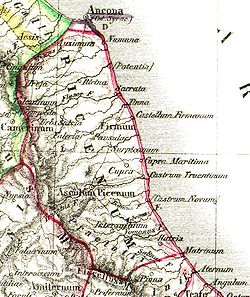Picenum
In ancient times, a landscape in central Italy was referred to as Picenum . It lay south of Umbria on the Adriatic Sea and was separated from the land of the Sabines by the Apennines , whose eastern foothills crisscrossed the Picenum. It was irrigated by many parallel small coastal rivers, including the Aesis ( Esino ), which marked the northern border, the Flusor ( Chienti ), the Tinna ( Tenna ), the Truentus ( Tronto ) and the Aternus ( Pescara ) which formed the southern border .
The inhabitants, Picentes, Piceni, also called Picentini (the name was derived from picus , woodpecker , after Mars sacred bird), belonged to the Sabellers and were considered to be soft and unwarlike. The Picentes closed in 299 BC. An alliance with Rome , but fell off again in 269. In the struggle that ensued, they were defeated by the consul Publius Sempronius Sophus and, after conquering their capital, Asculum (now Ascoli Piceno ), were subjected to Roman rule. The Social War 90-89, where the Picentes took a prominent part, gave this the Roman citizenship . The Picenum has been the 5th region of Italy since the Augustan period .
The most important cities in the country at the time of Roman rule were on the coast: Ancona (colony of Syracuse ), Firmum , Castrum Novum (founded by the Romans around 265) and Hadria ; inside: Asculum, Urbs Salvia and Interamnia . The Picenum was known for the production of oil, wine and fruit.
See also
literature
- Gerhard Radke : Picenum. In: The Little Pauly (KlP). Volume 4, Stuttgart 1972, Sp. 845-7846.
